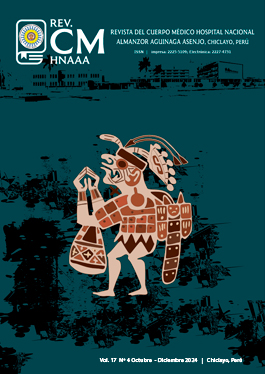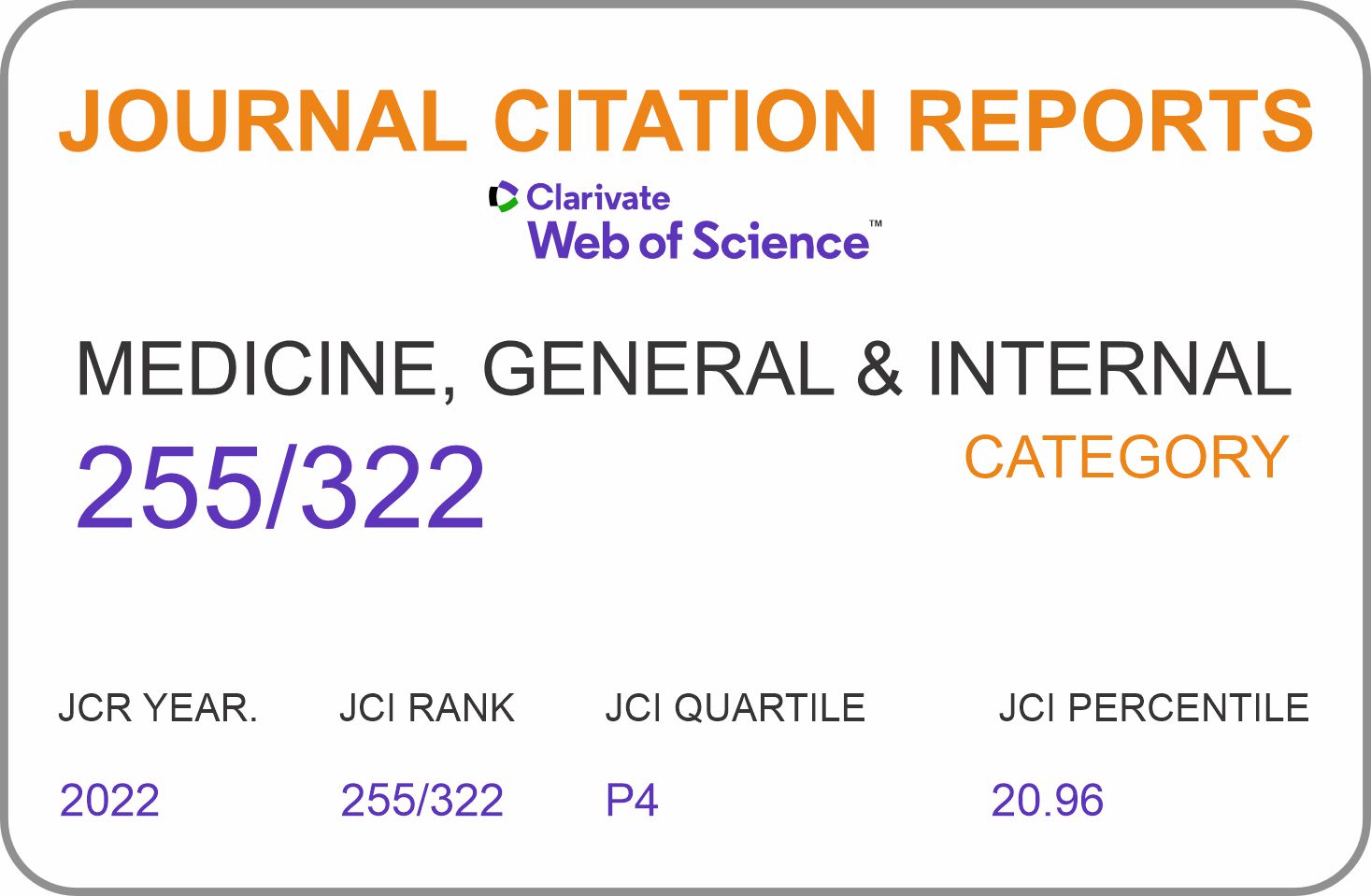Burnout syndrome and working conditions in nursing professionals in a surgical center of a national hospital in Peru in the context of COVID-19
DOI:
https://doi.org/10.35434/rcmhnaaa.2024.174.2378Keywords:
Burnout, nursing, working conditions, COVID-19, mental health, operating room nursingAbstract
Burnout syndrome affects nursing professionals and its relationship with working conditions is crucial. Objective:. Determine the association between SB and working conditions in nurses in a Peruvian hospital during 2020, in the context of COVID-19. Research. Prospective and analytical study, using the Maslach Burnout Inventory and a validated questionnaire on working conditions. Data were analyzed with association tests. Findings. Of 88 nurses, 12% had BS; 42,1% considered their working conditions adequate. A significant association was found between SB and global conditions of the work environment (p < 0,001). An increase in the working conditions score reduced the tendency (PR = 0,83; CI = 0,73-0,94; p = 0,004) and presence (PR=0.65; CI = 0,56-0,76; p < 0,001) of SB. Conclusions. Improving working conditions is positively linked to a decrease in SB in nurses in surgical centers.
Downloads
Metrics
References
Mbanga C, Makebe H, Tim D, Fonkou S, Toukam L, Njim T. Determinants of burnout syndrome among nurses in Cameroon. BMC Res Notes. 2018; 11(1): 893. doi: 10.1186/s13104-018-4004-3
International Statistical Classification of Diseases and Related Health Problems (ICD) [Internet]. World Health Organization (WHO). 2024 [citado 24 de octubre de 2019]. Disponible en: https://acortar.link/6KFpbT
Arab M, Rahimi A, Vali L, Ravangard R. Study of the relationship between nurses' work environment indices and their burnout aspects in TUMS teaching hospitals. IOH. 2012; 9(3): 39-51. https://acortar.link/6KFpbT
Ferreira NdO, de Lucca SR. Burnout syndrome in nursing assistants of a public hospital in the state of Sao Paulo. Rev Bras Epidemiol. 2015; 18(1): 68-79. doi: 10.1590/1980-5497201500010006
Abellanoza A, Provenzano‐Hass N, Gatchel RJ. Burnout in ER nurses: Review of the literature and interview themes. Journal of Applied Biobehavioral Research. 2018; 23(1): e12117. doi: 10.1111/jabr.12117
Grisales Romero H, Muñoz Y, Osorio D, Robles E. Síndrome de Burnout en el personal de enfermería de un hospital de referencia Ibagué, Colombia, 2014. Enferm Glob [Internet]. 2016 [Citado el 22 de agosto del 2024]; 15(41): 258-71. Disponible en: https://acortar.link/6KFpbT
Grau A, Flichtentrei D, Suñer R, Prats M, Braga F. Influencia de factores personales, profesionales y transnacionales en el síndrome de burnout en personal sanitario hispanoamericano y español (2007). Rev Esp Salud Pública [Internet]. 2009 [Cited 8 Agost 2024]; 83(2): 215-30. Available from: https://acortar.link/DCorbk
Solís-Cóndor R, Tantalean-del Águila M, Burgos-Aliaga R, Chambi-Torres J. Agotamiento profesional: prevalencia y factores asociados en médicos y enfermeras en siete regiones del Perú. An Fac Med. 2017; 78(3): 270-6. doi: 10.15381/anales.v78i3.13757
Szczygiel DD, Mikolajczak M. Emotional Intelligence Buffers the Effects of Negative Emotions on Job Burnout in Nursing. Front Psychol. 2018; 9: 2649. doi: 10.3389/fpsyg.2018.02649
Poghosyan L, Clarke SP, Finlayson M, Aiken LH. Nurse burnout and quality of care: cross-national investigation in six countries. Res Nurs Health. 2010; 33(4): 288-98. doi: 10.1002/nur.20383
Reader TW, Gillespie A. Patient neglect in healthcare institutions: a systematic review and conceptual model. BMC Health Serv Res. 2013; 13: 156. doi: 10.1186/1472-6963-13-156
Tsiga E, Panagopoulou E, Montgomery A. Examining the link between burnout and medical error: a checklist approach. Burnout Research. 2017; 6: 1-8. doi: 10.1016/j.burn.2017.02.002
Copanitsanou P, Fotos N, Brokalaki H. Effects of work environment on patient and nurse outcomes. Br J Nurs. 2017; 26(3): 172-6. doi: 10.12968/bjon.2017.26.3.172
Hämäläinen P, Takala J, Saarela KL. Global estimates of fatal work-related diseases. Am J Ind Med. 2007; 50(1): 28-41. doi: 10.1002/ajim.20411
de Paiva LC, Canário ACG, de Paiva China ELC, Gonçalves AK. Burnout syndrome in health-care professionals in a university hospital. Clinics (Sao Paulo, Brazil). 2017; 72(5): 305-9. doi: 10.6061/clinics/2017(05)08
Lai J, Ma S, Wang Y, Cai Z, Hu J, Wei N, et al. Factors Associated with Mental Health Outcomes Among Health Care Workers Exposed to Coronavirus Disease 2019. JAMA Netw Open. 2020; 3(3): e203976. doi: 10.1001/jamanetworkopen.2020.3976
Danet Danet A. Psychological impact of COVID-19 pandemic in Western frontline healthcare professionals. A systematic review. Med Clin (Barc). 2021; 156(9): 449-58. doi: 10.1016/j.medcli.2020.11.009
Galanis P, Vraka I, Fragkou D, Bilali A, Kaitelidou D. Nurses' burnout and associated risk factors during the COVID-19 pandemic: A systematic review and meta-analysis. J Adv Nurs. 2021; 77(8): 3286-302. doi: 10.1111/jan.14839
Viotti S, Gilardi S, Guglielmetti C, Converso D. Verbal Aggression from Care Recipients as a Risk Factor among Nursing Staff: A Study on Burnout in the JD-R Model Perspective. Biomed Res Int. 2015; 2015:215267. doi: 10.1155/2015/215267
Maticorena-Quevedo J, Beas R, Anduaga-Beramendi A, Mayta-Tristan P. Prevalencia del Síndrome de Burnout en médicos y enfermeras del Perú, ENSUSALUD 2014. Rev Peru Med Exp Salud Publica. 2016; 33(2): 241-7. doi: 10.17843/rpmesp.2016.332.2170
Maslach C, Jackson SE, Leiter MP. Maslach Burnout Inventory: Third edition. En: Zalaquett CP, Wood RJ (Eds.). Evaluating stress: A book of resources. Maryland: Scarecrow Education; 1997. p. 191-218.
García-Ubaque JC, Beltrán-Lizarazo AH, Daza-López ML. Autoevaluación de condiciones de trabajo de enfermería en alta complejidad. Av Enferm [Internet]. 2011 [Citado el 5 de Agosto del 2024]; 29(2): 331-41. Disponible en: https://acortar.link/DCorbk
Gamonal Mosaurieta YL, García Vargas CDM, Silva Mathews ZI. Síndrome de Burnout en el profesional de enfermería que labora en áreas críticas. Rev Enferm Herediana [Internet]. 2008 [Citado el 22 de enero del 2024]; 1(1): 33-9. Disponible en: https://acortar.link/DCorbk
Yang G, Liu J, Liu L, Wu X, Ding S, Xie J. Burnout and Resilience Among Transplant Nurses in 22 Hospitals in China. Transplant Proc. 2018; 50(10): 2905-10. doi: 10.1016/j.transproceed.2018.04.033
Anduaga-Beramendi A, Beas R, Maticorena-Quevedo J, Mayta-Tristán P. Association between burnout and intention to emigrate in Peruvian health-care workers. Saf Health Work. 2019; 10(1): 80-6. doi: 10.1016/j.shaw.2018.08.004
Sarmiento Valverde GS. Burnout en el servicio de emergencia de un hospital. Horizonte Médico (Lima). 2019; 19(1): 67-72. doi: 10.24265/horizmed.2019.v19n1.11
Dall’Ora C, Ball J, Recio-Saucedo A, Griffiths P. Characteristics of shift work and their impact on employee performance and wellbeing: A literature review. Int J Nurs Stud. 2016; 57: 12-27. doi: 10.1016/j.ijnurstu.2016.01.007
Casida JM, Combs P, Schroeder SE, Johnson C. Burnout and quality of work life among nurse practitioners in ventricular assist device programs in the United States. Prog Transplant. 2019; 29(1): 67-72. doi: 10.1177/1526924818817018
Ayala E, Carnero AM. Determinants of burnout in acute and critical care military nursing personnel: a cross-sectional study from Peru. PLoS One. 2013;8(1): e54408. doi: 10.1371/journal.pone.0054408
Murat M, Köse S, Savaşer S. Determination of stress, depression and burnout levels of front-line nurses during the COVID-19 pandemic. Int J Ment Health Nurs. 202; 30(2): 533-43. doi:10.1111/inm.12818
Published
How to Cite
Issue
Section
Categories
License
Copyright (c) 2025 Angélica Genoveva Vergara Mejía, Ludwing Zeta-Solis, Jhacksson Smit Córdova-Agurto, Hugo F. Gutiérrez-Crespo

This work is licensed under a Creative Commons Attribution 4.0 International License.















